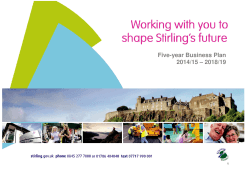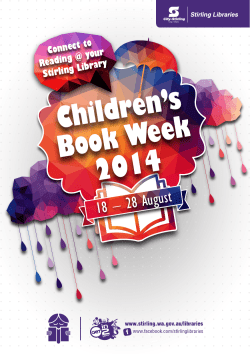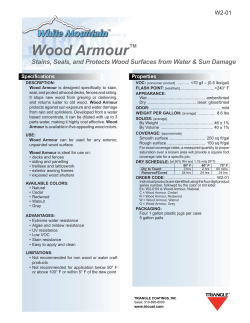
School Activity Packs visiting the MonuMent
School Activity Packs You can print copies of these packs, for use with your group before or after visiting The Monument ➞ Activity Pack 1 The National Wallace Monument The Battle of Stirling Bridge Including Scottish and English soldiers The characters of the battle Exclusive reports from the battle William Wallace - facts and figures N Abbey Craig Stirling Castle Education Pack 1 produced by The National Wallace Monument The Battle of Stirling Bridge ◆ Mark on this map the locations of • Abbey Craig • Stirling Castle • River Forth • Stirling Bridge • English Army • Scottish Army ◆ Why do you think it is important to mark the marsh on the map? ◆ Colour in the map appropriately. 1 The Battle of Stirling Bridge What advantages would the English bowman have over the Scottish bowman? Scottish Soldier English Soldier 2 The Battle of Stirling Bridge Below is a picture of a typical Scottish soldier dressed for the Battle of Stirling Bridge. • Label the different parts of his clothing and weaponry • Research the colours of his clothing and then colour him in. 3 The Battle of Stirling Bridge Below is a picture of a typical English soldier dressed for the Battle of Stirling Bridge. • Label the different parts of his clothing and weaponry • Research the colours of his clothing and then colour him in. 4 The Battle of Stirling Bridge Below each picture, make a list of how many soldiers and horses each army had. Remember to include the different kinds of soldiers. For example foot soldiers, cavalry, bowmen. Scottish Soldier English Soldier • In total, how many fought to support Scotland? • In total, how many fought to support England? • Were all the soldiers armoured? Yes No What was the reason for this? • Which army would have been expected to win the Battle? What were your reasons for this? 5 The Battle of Stirling Bridge • Do you know who’s who at the Battle of Stirling Bridge? Complete either the portrait or the name of the character - some of the clues may help you!. Scotland’s Freedom Fighter Leader of the English Army The Scottish hero who died shortly after victory The English knight who died at Stirling Bridge - legend has it that Wallace stripped his skin and wound it round the handle of his mighty sword Scotland’s Exiled King ‘The hammer of the Scots’ 6 The Battle of Stirling Bridge Imagine you are a soldier watching the Battle take place. It is your job to write a newspaper report about what you observed. Remember to add illustrations. AND Win FREE tickets for The National Wallace Monument see page 7 CHAMPION OF SCOTL s w e N y l i a D h s i t Scot City Edition N E S S AC C O U NT IT W E Y E E IV S U L A S O L D IE R ’S E X C THE BATTLE G N I L R I T S F O BRIDGE You can use a newspaper format like the one included in this pack, with picture space and columns 7 The Battle of Stirling Bridge Around this picture of William Wallace collect as many facts as you can about his life. • What qualities do you think he had that made him a great leader? 8 Win FREE tickets for The National Wallace Monument see page 7 CHAMPION OF SCOTLAND Scottish Daily News City Edition A SOLDIER’S EXCLUSIVE EYE WITNESS ACCOUNT THE BATTLE OF STIRLING BRIDGE Activity Pack 2 The National Wallace Monument Heraldry and Armour Including Coats of Arms The Wallace Sword Arms and Weaponry Squires, Knights and Tournaments Education Pack 2 produced by The National Wallace Monument Heraldry and Armour Coats of Arms ◆ What do you think this coat of arms says about William Wallace? ◆ Can you research the coat of arms of another person at the Battle of Stirling Bridge such as Andrew de Moray or King Edward 1 and record it below? ◆ ◆ What do you think this saying about him? Research and find out if your town, school or region has a coat of arms - many do. What does it say about the place it represents? 1 Heraldry and Armour Design your own coat of arms for yourself. Think about what you want it to say about yourself. Consider your hobbies, favourite pastimes, pets or family. Write about your choices and the reason you have chosen this coat of arms. 2 Design & Technology The Wallace Sword Design brief - to make a lifesize replica of Wallace’s sword using available classroom materials. Points to remember - the actual length of the sword the actual length of the blade The sword is double-handed Other considerations - when the sword was being restored in 1505 by King James IV, he ordered that... .... the sword be restored to a style more fitting to Scotland’s National Hero. ◆ What plans would you submit to King James IV to meet his order? 3 Arms & Weaponry These are a variety of weapons used during the time of Wallace and Bruce. Describe how they may be used. • Crossbow • Longbow • Slings • Lances • Boiling water, tar (pitch) ◆ Known as King Edward’s “War Wolf” how do you think this weapon was used? The Mangonel ◆ In what type of battle situation do you think this would be effective? ◆ Why was this not used by the English at the Battle of Stirling Bridge? ◆ Wallace fought using ‘Guerilla tactics’. What does this mean? 4 Time Traveller’s Name: A Squire When John was fourteen years old, he became a squire. He began training to be a knight. He helped Sir David, the knight. He looked after his armour and helped him to put it on. He learned how to ride one-handed, to keep his weapon arm free. Sir David, the knight, taught him how to fight with a sword and a lance. 1. What age was John when he became a squire? 2. What is a squire? 3. What did the squire help the knight to do? 4. Why did John have to learn to ride with one hand? 5. Name two weapons John learned to use? 6. Do you think John would have been allowed to use these weapons straight away? 7. What would he have used to learn with? 5 Time Traveller’s Name: Becoming a Knight John is very excited, because he is twenty-one and his squire training is finished. He is going to be a knight. First, he will spend the whole night praying for God to help him be a good Knight. He will not eat or sleep all night. Next morning, he will go to the Great Hall, and a squire will help him dress in his new armour. Sir David comes into the Great Hall and John kneels down in front of him. Sir David touches him gently on the shoulders with the flat of the sword pronouncing, “I dub thee a knight. Arise Sir John!” Use the storyboard sheet to retell the story in four parts. 1. John’s 21st birthday. How is he feeling, and what is he saying? 2. John is praying all night in the church. What is he thinking? 3. John is in the Great Hall with his squire. What is he wearing? 4. Sir David makes him a knight. What does John do? What does he say? 6 Time Traveller’s Name: Storyboard sheet Retell the story in four parts 7 Time Traveller’s Name: Armour Match the items of armour with the correct names, by drawing lines to connect them. • Helmet • Body Armour • Sword • Lance • Shield • Dagger • Axe 8 Time Traveller’s Name: A Knight in Battle Before going into battle or taking part in a tournament or jous joust,, the squire would help the knight to put on his armour. Carefully draw and label each feature (Underlined above). 9 Time Traveller’s Name: A Knightʼs Horse The most important thing to a knight was his horse. Why would his horse be the most important thing to him? Like the knight, the horse was also protected by armour Why would the horse need armour? Colour your armoured horse 10 Heraldry and Armour A Knight and his Armour INSTRUCTIONS Glue onto light card, then cut out the figure on the stand and base support. Cut along dotted lines at points B/B. Fold support at point A. Woolen Shirt Slot support through points B/B in figure stand. Carefully cut around the clothes on the following page including folding tabs. Breeches Linen Stockings FIGURE STAND B A B BASE SUPPORT A 11 Heraldry and Armour A Knight and his Armour Padded Cap Coif Helmet Hauberk Aketon 12 Heraldry and Armour A Knight and his Armour Surcoat Chausses Sword and Shield 13 Heraldry and Armour A Knight and his Armour INSTRUCTIONS Glue onto light card, then cut out the figure on the stand and base support. Fold along dotted lines. Make a spear from a wooden barbecue skewer. Attach paper spearhead. Cut out a pennant and attach to shaft. 14 Time Traveller’s Name: Tournaments As well as fighting in battles, knights liked to take part in games too. These fighting games were called TOURNAMENTS, which were very rough and dangerous. Each knight would have all his armour on, and would use a long lance. They would charge at each other on their horses and try to hit each other with their lances. Points were gained for hitting each other, and if his lance hit the helmet of the other knight, he gained a lot of points. Points were lost if he hit the horse. As the lances broke easily, and because the knight’s armour was so heavy, when he fell off the horse he found it very difficult to remount. These games would never last too long. The name given to this game was a JOUST. Look at your picture of a joust on page 16. The wooden fence between the two knights was called a TILT. What do you think it was for? Why do you think the knight had such a high back on his saddle? 15 The Joust 16 Time Traveller’s Name: A Knightʼs Lady Ladies often watched knights fighting in tournament. Sometimes a lady gave something like a glove, scarf or ribbon to her favourite knight. He took this into the joust with him. Make this model of the lady and colour her clothes which are on the following sheet. 17 Time Traveller’s Name: A Knightʼs Lady Necklace Head-dresses Dress Butterfly Find out what other clothes they may have worn. 18 Time Traveller’s Name: Are you fit enough? Discuss What kind of exercises would a knight have to do? Think of things you do in the gym. How would these help a knight? What part of your body do they help/strengthen? What skills do they make you better at? Unjumble these exercises Name of exercise Part of the body which it helps/strengthen tis pus urpeebs poer clingmib llwa rab inglmibc npipksig gnipsirtn pset sup drwafro llosr 19
© Copyright 2025





















